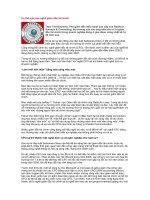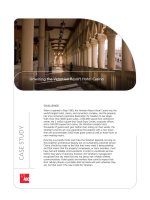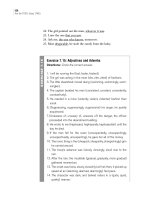Tài liệu PHP: The Good Parts: Delivering the Best of PHP- P6 doc
Bạn đang xem bản rút gọn của tài liệu. Xem và tải ngay bản đầy đủ của tài liệu tại đây (522.9 KB, 20 trang )
This, however, is a dynamically generated form, as you can see in the following code:
<?php
session_start();
$folder = $_SESSION['folder'];
$filename = $folder . "/question1.txt" ;
$file_handle = fopen($filename, "a+");
// open file for reading then clean it out
// pick up any text in the file that may already be there
$comments = fread($file_handle, filesize($filename));
fclose($file_handle); // close this handle
if ($_POST['posted']) {
// create file if first time and then
// save text that is in $_POST['question1']
$question1 = $_POST['question1'];
$file_handle = fopen($filename, "w+");
// open file for total overwrite
if (flock($file_handle, LOCK_EX)) {
// do an exclusive lock
if (fwrite($file_handle, $question1) == FALSE) {
echo "Cannot write to file ($filename)";
}
flock($file_handle, LOCK_UN);
// release the lock
}
// close the file handle and redirect to next page ?
fclose($file_handle);
header( "Location: page2.php" );
} else {
?>
<html>
<head>
<title>Files & folders - On-line Survey</title>
</head>
<body>
<table border=0><tr><td>
Please enter your response to the following survey question:
</td></tr>
<tr bgcolor=lightblue><td>
What is your opinion on the state of the world economy?<br/>
Can you help us fix it ?
</td></tr>
<tr><td>
<form action="<?= $PHP_SELF ?>" method=POST>
<input type="hidden" name="posted" value=1>
<br/>
<textarea name="question1" rows=12 cols=35><?= $comments ?></textarea>
</td></tr>
<tr><td>
File Management As a Database Alternative | 83
Please purchase PDF Split-Merge on www.verypdf.com to remove this watermark.
<input type="submit" name="submit" value="Submit">
</form></td></tr>
</table>
<?php } ?>
Let
me highlight a few of the lines of code here, because this is where the file manage-
ment and manipulation really takes place. After taking in the session information that
we need and adding the filename to the end of the $filename variable, we are ready to
start working with the files. Keep in mind that the point of this process is to display
any information that may already be saved in the file and allow users to enter infor-
mation (or alter what they have already entered). So, near the top of the code you see
this command:
$file_handle = fopen($filename, "a+");
Using the file opening function, fopen(), we ask PHP to provide us with a handle to
that file and store it in the variable suitably called $file_handle. Notice that there is
another parameter passed to the function here: the a+ option. If you look at the PHP
site, you will see a full listing of these option letters and what they mean. This one
causes the file to open for reading and writing, with the file pointer placed at the end.
If the file does not exist, PHP will attempt to create it. If you look at the next two lines
of code, you will see that the entire file is read (using the filesize() function to deter-
mine its size) into the $comments variable, and then it is closed.
$comments = fread($file_handle, filesize($filename));
fclose($file_handle);
Next, we want to see if the form portion of this program file has been executed, and,
if so, we have to save any information that was entered into the text area. This time,
we open the same file again, but we use the w+ option, which causes the interpreter to
open the file for writing only—creating it if it doesn’t exist, or emptying it if it does.
The file pointer is placed at the beginning of the file. Essentially, we want to empty out
the current contents of the file and replace it with a totally new volume of text. For this
purpose, we employ the fwrite() function:
// do an exclusive lock
if (flock($file_handle, LOCK_EX)) {
if (fwrite($file_handle, $question1) == FALSE){
echo "Cannot write to file ($filename)";
}
// release the lock
flock($file_handle, LOCK_UN);
}
We have to be sure that this information is indeed saved into the designated file, so we
wrap a few conditional statements around our file writing operations to make sure
everything will go smoothly. First, we attempt to gain an exclusive lock on the file in
question (using the flock() function)—this will ensure no other process can access the
file while we’re operating on it. After the writing is complete, we release the lock on
the file.
84 | Chapter 7: Database Interaction
Please purchase PDF Split-Merge on www.verypdf.com to remove this watermark.
As you can see, the file write function uses $file_handle to add the contents of the
$question1 variable to the file. Then, we simply close the file when we are finished with
it and move on to the next page of the survey, as shown in Figure 7-3.
Figure 7-3. Page 2 of the survey
As
you can see in the following code for page 2 of the survey, the code for processing
this next file (called question2.txt) is identical to the previous one, except for its name.
<?php
session_start();
$folder = $_SESSION['folder'];
$filename = $folder . "/question2.txt" ;
$file_handle = fopen($filename, "a+");
// open file for reading then clean it out
// pick up any text in the file that may already be there
$comments = fread($file_handle, filesize($filename));
fclose($file_handle); // close this handle
if ($_POST['posted']) {
// create file if first time and then save
//text that is in $_POST['question1']
$question2 = $_POST['question2'];
$file_handle = fopen($filename, "w+");
// open file for total overwrite
if (flock($file_handle, LOCK_EX)) { // do an exclusive lock
if (fwrite($file_handle, $question1) == FALSE) {
echo "Cannot write to file ($filename)";
}
flock($file_handle, LOCK_UN); // release the lock
}
// close the file handle and redirect to next page ?
fclose($file_handle);
header( "Location: last_page.php" );
File Management As a Database Alternative | 85
Please purchase PDF Split-Merge on www.verypdf.com to remove this watermark.
} else {
?>
<html>
<head>
<title>Files & folders - On-line Survey</title>
</head>
<body>
<table border=0><tr><td>
Please enter your comments to the following survey statement:
</td></tr>
<tr bgcolor=lightblue><td>
It's a funny thing freedom. I mean how can any of us <br/>
be really free when we still have personal possessions.
How do you respond to the previous statement?
</td></tr>
<tr><td>
<form action="<?= $PHP_SELF ?>" method=POST>
<input type="hidden" name="posted" value=1>
<br/>
<textarea name="question2" rows=12 cols=35><?= $comments ?></textarea>
</td></tr>
<tr><td>
<input type="submit" name="submit" value="Submit">
</form></td></tr>
</table>
<?php } ?>
This
kind of file processing can continue for as long as you like and, therefore, your
surveys can be as long as you like. To make it more interesting, you can ask multiple
questions on the same page and simply give each question its own filename.
Of course, after a few pages, with as many as five questions per page, you may find
yourself with a large volume of individual files needing management. Fortunately, PHP
has other file handling functions that you can use. The file() function, for example,
is an alternative to the fread() function that reads the entire contents of a file in an
array, one element per line. If your information is formatted properly—with each line
delimited by the end of line sequence \n—you can store multiple pieces of information
in a single file very easily. Naturally, this would also entail the use of the appropriate
looping controls for handling the creation of the HTML form, as well as recording the
entries into that form.
When it comes to file handling, there are still many more options that you can look at
on the PHP website. If you go to the “Filesystem” section of the manual, you will find
a list of over 70 functions—including, of course, the ones discussed here. You can check
to see if a file is either readable or writable with the is_readable() or is_writable()
functions, respectively. You can check on file permissions, free disk space, or total disk
space, and you can delete files, copy files, and much more. When you get right down
86 | Chapter 7: Database Interaction
Please purchase PDF Split-Merge on www.verypdf.com to remove this watermark.
to it, if you have enough time and desire, you can even write an entire web application
without ever needing or using a database system.
When the day comes (and it most likely will) that you have a client who does not want
to pay big bucks for the use of a database engine, you will have an alternative approach
to offer them.
File Management As a Database Alternative | 87
Please purchase PDF Split-Merge on www.verypdf.com to remove this watermark.
Please purchase PDF Split-Merge on www.verypdf.com to remove this watermark.
CHAPTER 8
PHP and Friends
PHP is a wonderful language—it is robust and flexible and friendly. By friendly, I mean
that it can freely integrate with libraries built by outside sources. This is in keeping with
an important and ever-present caveat in the open source development world: not re-
inventing the wheel. There are many different libraries out on the Web that can inte-
grate well with PHP and are actually also developed in PHP. In this chapter, we will
look at three different PHP add-on libraries and discuss how to use existing tools to
enhance our PHP web development.
The three libraries we’ll cover are all PHP object-oriented-based, so be sure you have
read Chapter 6 in this book or are familiar with object-oriented programming before
going too far into the examples. These three libraries were chosen because they are
helpful for performing some of the top tasks in a modern web-based application: send-
ing email messages or Short Message Service (SMS) text messages, generating PDF
forms, and generating graphical data reports (e.g., pie charts and bar charts).
Email/SMS Generation
PHP has a built-in mail function called
mail()
. This will send out Simple Mail Transport
Protocol (SMTP) mail to the world. The mail function is quite simplistic and basic, so
it usually is not the best choice, on its own, for heavier email tasks. It’s tricky to send
email messages with attachments, for example.
The PHP library, called PHPMailer, is just what the doctor ordered to fill the gap. It is
object-based and you can add it easily into a script with either an
include
or, more
appropriately, a
require
c o m m a n d . Y o u c a n f i n d t h e P H P M a i l e r l i b r a r y a t t h e f o l l o w i n g
URL: />89
Download at Wow! eBook
Please purchase PDF Split-Merge on www.verypdf.com to remove this watermark.
If you have control over your server and where files are to be located,
you should consider placing this library in a commonly accessible folder
so that all of your PHP applications can share access to it, thus prevent-
ing multiple installations of the same library. This will also help with
maintaining the most current version of the library across all of your
websites. If you want the library to be available to all PHP files, you can
move the class.phpmailer.php file into your php.ini include path. This is
true for all the libraries that are covered in this chapter.
After you have made reference to the PHPMailer class with a require command, simply
instantiate the class and start using it. Consider the following simple example taken
from the PHPMailer installation guide:
require("class.phpmailer.php");
$mail = new PHPMailer();
// set mailer to use SMTP
$mail->IsSMTP();
// specify main and backup server
$mail->Host = "smtp1.example.com;smtp2.example.com";
// turn on SMTP authentication
$mail->SMTPAuth = true;
// SMTP username
$mail->Username = "petermac";
// SMTP password
$mail->Password = "secret";
$mail->From = "";
$mail->FromName = "Mailer";
// name is optional
$mail->AddAddress("", "Josh Adams");
$mail->AddAddress("");
$mail->AddReplyTo("", "Information");
// set word wrap to 50 characters
$mail->WordWrap = 50;
// add attachments
$mail->AddAttachment("/var/tmp/file.tar.gz");
// optional attachment file name
$mail->AddAttachment("/tmp/image.jpg", "new.jpg");
// set email format to HTML
$mail->IsHTML(true);
$mail->Subject = "Here is the subject";
$mail->Body = "This is the HTML message
body <b>in bold!</b>";
$mail->AltBody = "This is the body in plain text for
non-HTML mail clients";
90 | Chapter 8: PHP and Friends
Please purchase PDF Split-Merge on www.verypdf.com to remove this watermark.









